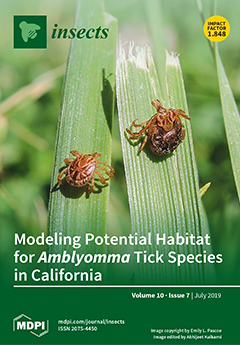A major challenge to the area-wide management of
Drosophila suzukii is understanding the fly’s host use and temporal dynamics, which may dictate local movement patterns. We determined
D. suzukii’s seasonal host use in California’s San Joaquin Valley by sampling common crop and
[...] Read more.
A major challenge to the area-wide management of
Drosophila suzukii is understanding the fly’s host use and temporal dynamics, which may dictate local movement patterns. We determined
D. suzukii’s seasonal host use in California’s San Joaquin Valley by sampling common crop and non-crop fruits in a temporal sequence of fruit ripening. We then evaluated the suitability of selected fruits as hosts.
Drosophila suzukii emerged from both intact and damaged cherries during the cooler, early season period. Fly density remained low through the hot spring–summer period and re-surged as temperatures lowered in fall when the fly did not cause damage to intact peach, nectarine, plum, pear, grape, pomegranate, apple, persimmon and citrus (in order of ripening) but did emerge from the damaged fruits of these crops. The fly also emerged from two ornamental fruits (loquats and cactus) but was not found on wild plum and two endemic wild fruits (buckthorn and bitter berry).
Drosophila suzukii completed development (egg to adult) on cactus, mandarin carpel, pomegranate seed, wild plum and buckthorn at survival rates similar to cherry (51.2–68.8%), whereas it had a lower survival rate on bitter cherry (33.2%), table grape (31.5%), raisin grape (26.5%), and wine grape (4.5%). The high acidity levels of grapes negatively affected the fly’s fitness. Among 10 cherry cultivars, survival rate was not affected by sugar content, but it decreased with increasing egg density per gram of fruit. Results suggest that in California’s San Joaquin Valley, the early season crops are most vulnerable, summer fruits ripen during a period of low pest pressure, and late season fruits, when damaged, serve to sustain
D. suzukii’s populations in this region.
Full article






